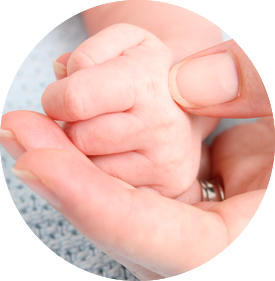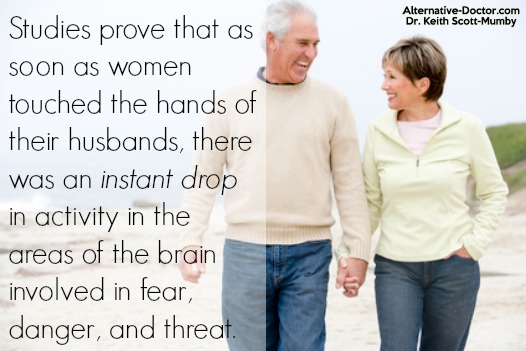Simple healing touch therapy is the unequalled king of all communications!
When you touch someone or something, you have a direct physical connection between yourself and the person or thing—impossible with written words, images or video. What’s more, it’s fast—you can transfer a lot of information in just a few seconds, which you can’t by talking about yourself or your feelings!
For all our reticence about touching, especially with strangers, touch can enable us to communicate our feelings with an astonishing accuracy. Whereas visually the only really reliable emotion that can be identified is joy or delight, participants in a 2009 scientific trial run by psychologist Matthew Hertenstein of DePauw University were able to communicate eight distinct emotions—anger, fear, disgust, love, gratitude, sympathy, happiness, and sadness—with accuracy rates as high as 78 percent.
A Mother’s Healing Touch Therapy
Touch is our first language.

We begin receiving tactile signals even before birth, as the vibration of our mother’s heartbeat is amplified by amniotic fluid. Her voice is the first human communications we hear, even though we don’t understand the language as yet. It’s just a reverberation in the waters.
Mother has many other body sensations too which transmit to the fetus, from breaking wind to sexual arousal. The developing fetus gets it all!
After birth, a mother’s touch enhances attachment between mother and child. One of the key physiological phenomena behind gentle touch is the release of the “cuddle hormone”, oxytocin. It’s a two-way traffic; the one touching receives a similar hormone “dose” to the one being touched. Studies have shown that a person giving a hug gets just as much benefit as a person being hugged.
Touch Against Fear and Anxiety
In a series of classic experiments, Jim Coan, a neuroscientist at Virginia University, ran brain scans of married women subjected to strong pain. The women were stressed, of course, even though this was a voluntary experience. But as soon as the women touched the hands of their husbands, there was an instant drop in activity in the areas of the brain involved in fear, danger, and threat. The women reported feeling calmer and less stressed, as soon as they felt a familiar touch.
There was a similar, but smaller, effect triggered by the touch of strangers. But help from strangers can be very striking indeed. Ayana Byrd, writing in Good Housekeeping, tells a great story:
Though her passport is full of stamps, Ayana describes herself as the coward of all fliers. For years, every trip involved her taking herbal sedatives, followed by half a sleeping pill as soon as she boarded, followed by a drink of wine to nudge things along. The worst flight of her life was a 90-minute ride in a rickety, about-to-fall-out-of-the-sky plane in South Africa.
As she sat in her turbulence-rattled seat and wept, sure that everyone onboard was going to die, a stranger saw her, went over, and said she could hold her hand until she (Ayana) felt better. The stranger probably didn’t think that would be for the entire flight, but it was! Ayana couldn’t let go. The stranger’s soft skin and firm grip left her feeling more at ease than she’d ever been on a plane.
Here’s the good part: now, amazingly, all it takes to keep Ayana calm on flights is remembering that stranger’s touch. No more sleeping pills.
Spiritual Powers
Stories of divine miracles often rely on touch. Christian healing parables of this genre, such as Jesus reviving the dead, are well-known in the West. However there are many other similar tales of magical touch in other cultures and religions.
The context may not even require religious overtones, just intense love. The revival of dead baby Ogg is well documented. Jamie Ogg was born premature at 27 weeks in 2010, pronounced dead, but then revived simply by his mother’s touch. As mother Kate Ogg bid her son a sad goodbye, she hugged and soothed him, telling him his twin sister Emily was fine and that she loved him.
Five minutes later, the couple noticed their son gasping for air. He revived in full and grew to a normal life. This is an example of what today is called “kangaroo care” of premature babies; a reflection of the marsupial nurturing pouch of the mother.
New research is undermining old and wretched “scientific” notions, like the no-touch rule for premature babies. Gentle massage of preemies in their incubator has been found to reduce mortality and help them grow normally and develop along balanced functional lines.

Healing Touch Therapy
Touch probably comes into its own in the field of healing. In the 1970s I was an examiner for The St John Ambulance Brigade in Manchester, UK. I would give the first-aiders their final test; most were very good indeed. Invariably, I took the opportunity to hand out an info card, detailing several touch remedies.
Here is an example of one of those:
Feel My Hands
As everyone knows, holding an injured part is comforting. If a special person holds it for you, that’s even better!
We can adapt this simple property to get remarkable results. If a person is hurt or injured, and in pain, you can put your hand(s) in contact with his or her body and ask them to “feel” your hand(s).
Get all the first aid stuff out of the way first: removal from danger, sitting or lying safely, stop the bleeding, a bandaid, splints or bandages and so forth. Call an ambulance if you have to. Then do “Feel My Hands”.
Take control and with a reassuring, calm voice, touch the patient’s body with one or both hands (both is better) and say, “Feel my hand(s).”
Get a reply that tells you the patient is cooperating and acknowledge. Then move your hands to another position and repeat the command, “Feel my hand(s),” etc.
Work around but not directly on the injured part; avoid any touch which would intensify the pain. If the person is apprehensive because of this, you can begin on a distant part of the body, then gradually work towards the injured area. Let him or her gain assurance that the soothing of pain is the aim, not provocation of the injury.
Really, the target is not the injured limb or zone, so don’t get obsessed with that. The real target is the neurological system and connective tissues of the whole body. You are re-establishing the patient’s communication with their own body, using touch as a cue. We want to re-connect.
To stimulate this re-opening of communication pathways, make a point of placing your hands distal (further from the head) to the injured part. That way the body is coaxed into “looking” beyond the injury and so opening up the networks.
Another important point is to work on both sides of the body equally. It is wrong to think pain affects only the injured part: pain rides as a shockwave throughout the entire body, including crossing over to the other side in a sort of mirror effect.
Sometimes you may not even be able to get at the injured part; it could be covered in bandages, a splint or a cast. In which case work diligently on the opposite side of the body, at the corresponding site to the injury. You be amazed how well this works.
Applications: sprains, fractures, cuts and tears, blows, dental work, falls, scuffs and puncture wounds. Remember your usual head injury warnings.
Final Note
A person can fool you with words or gestures. But this knocks so-called “body language” into a cocked hat. Healing touch therapy is real, present and can’t be dissembled. It is, in truth, the only way you are really going to know what a person is thinking.
It’s powerful and positive. If you hold someone’s hand while you talk to them, you can stoke up the meaning and level of rapport quite easily.
Touch appears over and over in our lives as something enriching, educational, soothing and purposive. Women will readily report the especially pleasant feelings of having their hair brushed or mussed, of having fingernails polished and toenails clipped.
Men don’t get enough of this sort of rapport and we need more. Something is lacking in just the touch of a fishing rod, carpenter’s tools, wood or metal!
My wife heals me in bed virtually every night, prior to sleep, and I can extol its powerful virtues. By “healing” I mean she gets into communication with Higher Power and passes this rapture into my tired body, by means of stroking and loving touch. I’d like to think my medical wisdom has something to do with my Peter Pan days but I’m sure that this nightly ritual, too, adds to my years of pleasure and vigor on this Earth.
Want More on The King of All Communications & Healing Every Aspect of Your Life?
You see, touch is a key component of very many traditional healing arts, from Reiki to acupressure; massage to reflexology; and is being increasingly studied in mainstream medicine. Scientific research shows that not only does the healing power of touch lower stress levels, but it can also boost the immune system and halt or slow the progression of disease.
I like to teach what is like nutrition for mind and spirit as well as the body. You see…in order for you to achieve true health — health and wellness in the fullest sense — this includes knowledge that can heal your mind, body, and spirit.
With that end in mind, I’ve created the book, Healing Your Life.
Healing Your Life is a HUGE compilation of tips, tricks, hacks, techniques and teachings. I call these teachings: rubrics (little formulas or routines).
It will change your life: that’s exactly how I designed it. Healing Your Life is the best possible introduction to the wealth of new advanced ideas and breakthroughs for your mind, spirit, and body — that I have been able to come up with, over the space of some 40 years.
Plus, when you get your copy of Healing Your Life today – you will receive my newly released bonus report that reveals 12 degrees of TOUCH for ultimate healing using “The King of All Communications.”
References:
1. Hertenstein, M. J. (2011). The communicative functions of touch in adulthood. In M. Hertenstein & S. Weiss, (Eds.), The handbook of touch: Neuroscience, behavioral, and applied perspectives. New York: Springer Publications.
2. Byrd, A. (2012, January 3). The Power of Touch. Good Housekeeping.
3. Inbar, M. (2010, September 3). Mom’s hug revives baby that was pronounced dead. Today Parenting.
